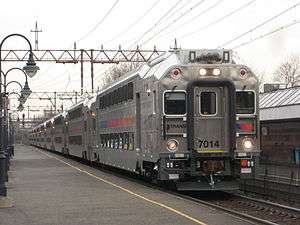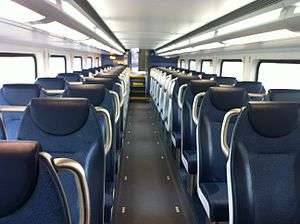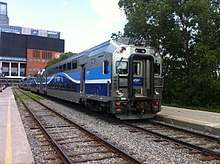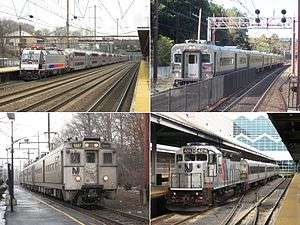Bombardier MultiLevel Coach
The Bombardier MultiLevel Coach[2][3] is a bi-level passenger rail car manufactured by Bombardier for use on commuter rail lines. The first units were delivered in 2006 and deliveries (in various orders) continued to 2014.
| Multi-Level Coach | |
|---|---|
 NJ Transit MultiLevel cab car #7014 lead train 6651 at Millburn | |
 Interior of an Exo MultiLevel coach | |
| In service | 2006-present |
| Manufacturer | Bombardier Transportation |
| Built at | La Pocatière, Quebec and Plattsburgh, New York |
| Replaced | All remaining Arrow III All remaining Comet I/IBs/IIs/IIIs All remaining MARC IIAs All remaining SEPTA Silverliner IVs |
| Constructed | 2006–2009 (NJT base order) 2012–2013 (NJT series II) 2008–2011 (Exo) 2014 (MARC) 2021-2024 (SEPTA) |
| Entered service | 2006–2013 (NJT) 2009–2011 (Exo) 2014–2016 (MARC) |
| Number built | 643 |
| Number in service | 643 |
| Capacity | 127 (cab car)[1] 132 (trailer car with restroom)[1] 142 (standard trailer car)[1] |
| Operator(s) | NJ Transit, Exo, MARC (Amtrak), SEPTA |
| Specifications | |
| Car body construction | Stainless steel |
| Car length | 85 ft (25.91 m)[1] |
| Width | 10 ft 0 in (3.05 m)[1] |
| Height | 14 ft 6 in (4.42 m)[1] |
| Floor height | 4 ft 3 in (1.295 m)[1] |
| Maximum speed | 100–110 mph (161–177 km/h)[1] |
| Weight | 139,250 lb (63,163 kg) (cab car)[1] 134,880 lb (61,181 kg) (trailer car with restroom)[1] 132,990 lb (60,323 kg) (standard trailer car)[1] |
| Power supply | 480 V AC, 60 Hz, 3-phase[1] 12.5 kV-25 kV AC SEPTA |
| Braking system(s) | Pneumatic disc and shoe[1] |
| Track gauge | 1,435 mm (4 ft 8 1⁄2 in) standard gauge[1] |
Overview
There are 643 of these coaches in service as of 2015 on NJ Transit, Exo, and MARC. NJ Transit received 429 cars, including 62 cab cars, while Exo's predecessor, Agence métropolitaine de transport (AMT), received 160 cars, including 26 cab cars. The MARC order consists of 39 trailers and 15 cab cars.
The coaches were based on the Comet V and have a two-by-two seating arrangement and more knee and leg room than single-level coaches. The seats are also bigger and it has 15-30% more seating than on single-level coaches. The intermediate levels have 5 inward-facing seats on each side which flip up for wheelchairs or bicycles. On cab cars, a large equipment locker behind the cab replaces one row of seats. There are single-width side doors at intermediate levels for high-platform loading, and similar doors outboard of the bogies except at the cab position on cab cars. The latter doors of NJ Transit coaches have stepwell trapdoors, allowing these doors to be used for both high and low-platform loading. Exo coaches have one-piece end doors without traps, which can be used only for low-platform loading. There are also an automated announcement system and LED destination screens.
Eight MultiLevel cars were previously designated for the now-discontinued Atlantic City Express Service. These included the addition of first class seating sections and lounge facilities. After the ACES was discontinued in 2012, the cars were converted to regular NJT cars by Bombardier from 2013 until 2014. They re-entered NJT service in mid-2014.[4]
Service history
The first order for the coaches was placed in December 2002 by NJ Transit when it purchased 100 cars, with deliveries beginning in 2005.[5] In September 2005, the agency ordered 131 additional cars.[6] After exercising further contract options, the last order of which was placed in August 2008, a total of 329 first-generation cars were eventually purchased by NJ Transit.[7][8]
In December 2007, AMT placed an order for 160 cars via a base order for 30 units and options for 130 more, though all options were exercised immediately. The cars bagan to enter service in late 2009.[9]
In September 2010, NJ Transit ordered 100 additional coaches, with options for 79 more.[7] In October 2011, MARC Train ordered 54 cars—15 cab cars and 39 trailing cars—from the NJ Transit options.[10]
In December 2018, NJ Transit ordered 113 new electric multiple unit coaches, designated MultiLevel III; the order included 58 units with AC electric propulsion systems and 55 unpowered cars.[11] The contract included options for up to more cars for NJ Transit, as well as 250 cars (including power cars) for SEPTA Regional Rail.[11] The cars are to replace NJ Transit's Arrow III EMUs, as well as SEPTA's Silverliner IV EMUs and Comet II/III cars.
Gallery
 NJ Transit Multilevel II coach at Newark Penn Station
NJ Transit Multilevel II coach at Newark Penn Station Exo 3000-series MultiLevel coach at Lucien-L'Allier station
Exo 3000-series MultiLevel coach at Lucien-L'Allier station MARC IV MultiLevel coach at Odenton station
MARC IV MultiLevel coach at Odenton station
See also
References
- "Summary Minutes MARC Riders Advisory Council Meeting" (PDF). Bombardier (via MARC Riders Advisory Council). May 16, 2013. Archived from the original (PDF) on November 18, 2014. Retrieved December 20, 2018.
- Bombardier. "Multilevel Coaches in the USA and Canada". Retrieved June 23, 2010.
- https://web.archive.org/web/20141118062504/http://mta.maryland.gov/sites/default/files/minutes-2013-05-16-with-handouts-1.pdf Page 10
- https://www.webcitation.org/query?url=http%3A%2F%2Fsuperstormsandyrecovery.com%2Fimg%2Fdocuments%2FBombardier%2520Change%2520Order%2520Docs.pdf&date=2014-04-30
- "N.J. Transit Buying New Cars to Ease Crowds". The New York Times. December 12, 2002. Retrieved December 20, 2018.
- "New Jersey Transit orders another 131 cars from Bombardier". Progressive Railroading. September 28, 2005. Retrieved December 20, 2018.
- "Bombardier Transportation awarded $267 million railcar contract". Press-Republican. September 1, 2010. Retrieved December 20, 2018.
- "World rolling stock market September 2008". Railway Gazette International. September 27, 2008. Retrieved December 20, 2018.
- "Bombardier to supply 160 cars for Montreal commuter service". Trains Magazine. December 18, 2007. Retrieved December 20, 2018.
- "MARC to purchase 54 bi-level commuter cars". Trains Magazine. November 4, 2011. Retrieved December 20, 2018.
- "It's official: Bombardier signs with NJ Transit for Multilevel III contract". Railway Age. January 9, 2019. Retrieved February 14, 2019.
External links
| Wikimedia Commons has media related to Bombardier MultiLevel Coach. |
